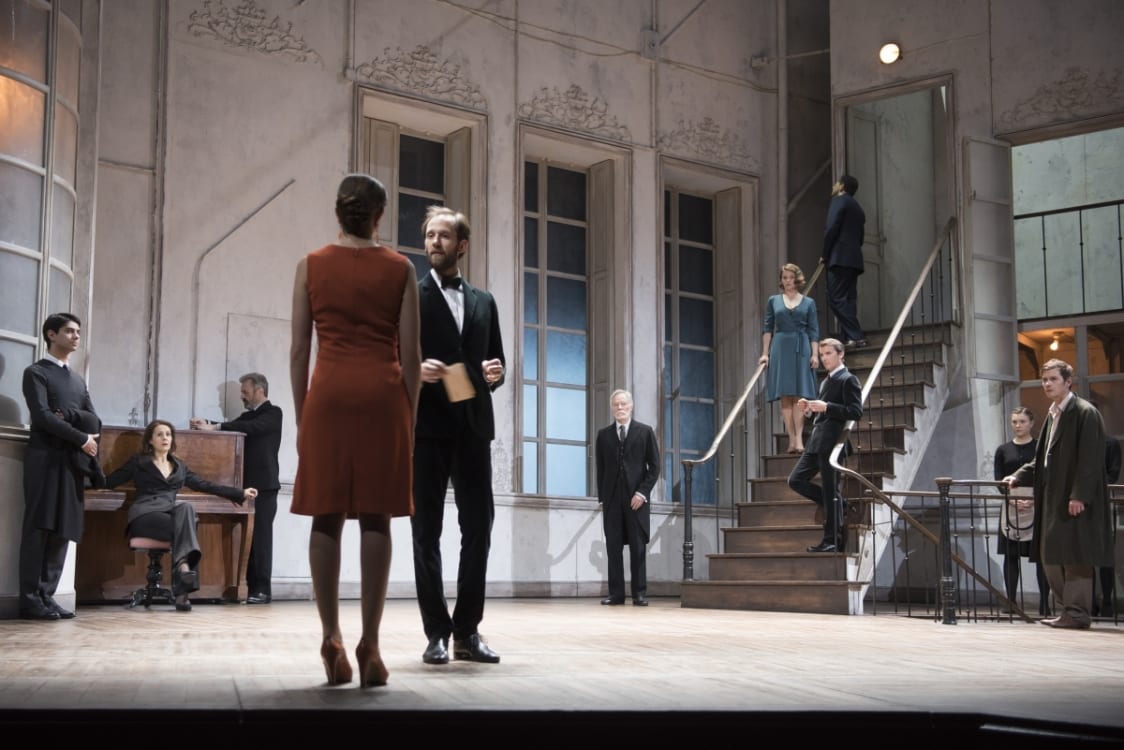Molière’s Le Misanthrope is a French classic from 1666, and its main character Alceste is one of the most famous characters in French theatre. In Clément Hervieu-Léger’s take on the play, Alceste, played by Loïc Corbery, enters quietly onto the stage of the Salle Richelieu while the audience is taking their seats. From the beginning, his portrayal of the character of Alceste is clear: he walks the stage, looking morose and watching the public, or he sits, his head in his hands, next to a chandelier that is on the floor. At the very beginning of the play, he is already a silent misanthropist. The set he walks around looks like a part of a rich apartment with mouldings and luxurious furniture, but they are covered, the walls are grey, and a neon light crackles. Alceste seems to be waiting, and does not seem to be at ease: this must not be his home.
Loïc Corbery’s Alceste is not from Molière’s era – the set makes it clear that he belongs in the 20th century, although his messy hair and long coat make him look like Friedrich’s Wanderer above the Sea of Fog. This Alceste is a Romantic, his pessimism reminding us of Rimbaud or Baudelaire.
Indeed, Alceste more or less hates mankind and mankind’s hypocrisy. His love for the lively Célimène (Georgia Scalliet) drives him mad, and his madness is intensified when he is confronted by the other men who court her. These two conceited marquises, brilliantly played by Benjamin Lavernhe and Clément Hervieu-Léger, bring a touch of humour to the play. Their velvet suits make them look like pretentious and ridiculous dandies and make them stand out from the others, in a caricatured but effective way. The costumes, designed by Caroline de Vivaise, are sober but also extremely clever; you can understand who the characters are just by looking at their clothes. Serge Bagdassarian is hilarious as Oronte, the eccentric failed poet with his high-pitched voice and his orange suit.

Even if the tone of the play is often funny, it never hides its serious, deep and pessimistic dimension. This is even expressed through the play’s design (created by Eric Ruf). The piano, for example, is sometimes used to cut short dialogue. Alceste does not want to hear the advice of Arisnoé (Florence Viala), so he plays the piano to stop her from talking. This clever and amusing use of the instrument is countered by its power to create a mood of dark melancholy when the characters express their anger with piano keys.
This ambiguity is perfectly embodied by the character of Philinte (Eric Génovèse), Alceste’s faithful friend. Génovèse portrays a fascinating secondary character, who tries to help Alceste be kind to others in order to adapt and win Célimène’s heart. He follows Alceste everywhere, bringing a touch of sarcasm that Génovèse uses so well and that Molière probably would have loved. However, his character is controversial, and he brings great intensity to the play’s wonderful and dark ending. Bathed in cold light, Alceste, humiliated and despairing, slowly exits the stage going down the stairs, watched by Philinte. He, in the middle of the stage, is clearly torn between his lover Eliante (Adeline D’Hermy) and Alceste, and after many moments of visible hesitation (his body swings from one to the other), he chooses Eliante and runs up the stairs with her. This final scene, enhanced by Jean-Luc Ristord’s sound design, is intense and cruel, making us think that the production could have been a masterpiece if it had been this powerful throughout.

